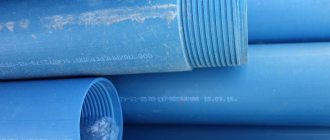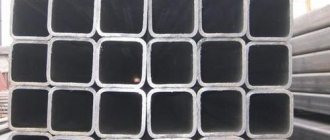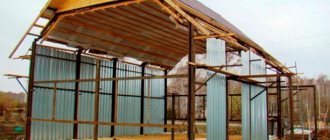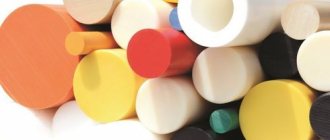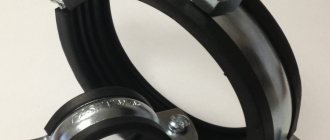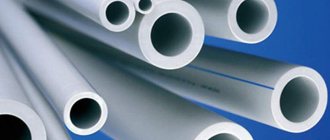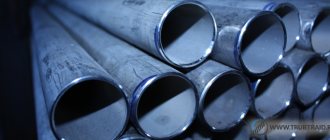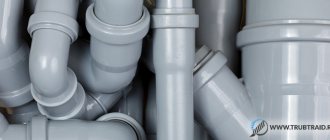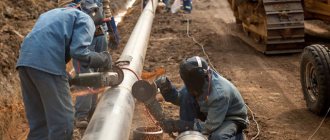Viniplast is the same as PVC, but various stabilizers, dyes, and lubricants have been added to its structure.
Due to this, it has greater resistance to various types of influences.
It is these qualities that have made its use very popular in the field of sewerage, electrical wiring and even water supply.
- 2 Characteristics
- 3 Installation features
- 4 Welding vinyl plastic pipes
Peculiarities
In terms of its properties, such a material is very rigid and opaque, made from a polymer mass, without the use of plasticizers.
It is based on vinyl resins and polyvinyl chloride. At the same time, to impart the necessary physical properties, antioxidants, heat stabilizers, as well as various coloring pigments and light stabilizers are added to the composition.
Thus, thanks to stabilizers, it was possible to achieve resistance of the material to various influences during its operation. And the addition of coloring pigments makes it possible to give finished products any desired color.
This material is considered to be non-plasticized polyvinyl chloride, but it contains a small amount of plasticizers. The maximum amount of this substance for the entire volume is no more than 10%. Also, this material adheres perfectly to various surfaces, from wood to concrete or even metal.
Due to the specific composition of the material used, the finished vinyl plastic pipe has excellent resistance not only to high temperatures, but also to various acids and alkalis.
In addition, the product is non-flammable, and its welding requires a temperature of over 250˚C. Such parts also adhere perfectly to each other, and as a result, a joint is formed whose strength is only slightly inferior to the overall strength of the product.
It is very common to use vinyl plastic pipes for:
- laying electrical wiring;
- creating ventilation;
- arrangement of water supply or sewerage.
Vinyl plastic as a material
Viniplast is a type of plastic. It is a plastic mass based on polyvinyl chloride with the addition of resin. The second name for vinyl plastic is unplasticized polyvinyl chloride (UPVC). The material is called unplasticized because when it is produced, plasticizers, which are used in the construction industry to improve the characteristics of the material, are not introduced into the composition.
The material is manufactured in accordance with regulatory regulations. GOST for vinyl plastic has the number 9639-71. GOST represents the technical conditions for the manufacture of unplasticized polyvinyl chloride sheets; grades of the material are also presented.
- plasticity indicator - the material does not collapse with small deformations;
- resistance to aggressive environmental influences, acidic and alkaline environments;
- does not emit hazardous substances at temperatures of use up to 80 degrees Celsius;
- dielectric quality (does not allow electric current to pass through, can be used without fear);
- strength;
- resistance to fire;
- manufacturability and ease of processing, which led to the use of industry;
- connecting products to each other is carried out in three ways (gluing, welding, drilling holes);
- Vinyl plastic material is welded with electrodes used for metal.
The disadvantages include:
- instability to aromatic hydrocarbons, high concentrations of nitric acid, ethers and organic solvents;
- impossibility of storage in open areas and those in which the temperature is above 35 degrees Celsius, next to heating devices;
- the need to keep the material for 24 hours in a room with a temperature of 20 degrees Celsius if it was transported at subzero temperatures.
These disadvantages are more conditions of use and features than disadvantages of vinyl plastic.
- food industry;
- medical industry;
- in construction for finishing floors and walls;
- film production;
- make artificial leather;
- in electrical engineering for cable insulation;
- for the manufacture of equipment parts;
- details of plastic doors and window fillings;
Facebook - LiveJournal
- Blogger
The material is in demand in areas of human life and has proven itself to be a safe and technologically advanced raw material for production areas.
Characteristics
Based on the area where the product is used, its technical characteristics depend.
Thus, variants of pipes used in the installation of pressure water pipelines are also used for gravity sewerage equipment.
This is due to their resistance when working with high pressure (standard options up to 16 amperes, reinforced up to 32), as well as long-term operation at high temperatures. Most often, the size of the pipes is up to half a meter. To create strong, sealed connections, they try to use either cold welding or fittings.
Please note: pipe options used to create sewer networks have increased resistance to rust, scale or salt deposits. At the same time, they are less susceptible to mechanical influences.
It is thanks to the creation of three-layer extrusion that manufacturers are able to produce products with such characteristics. And even if the material freezes completely, it will not crack, and its use is possible even at a depth of 5 meters. In addition, vinyl plastic pipes are very easy to install without additional tools.
In the field of electrical wiring, they try to use corrugated versions of vinyl plastic pipes with a diameter of 25 mm.
This is due to the fact that they have dielectric properties and are also resistant to fire.
There are several types of them: reinforced and double-walled. The difference between them lies in the level of ring stiffness. Due to their structure, they are often used in areas of high vibration.
What is vinyl plastic?
In terms of its structure, vinyl plastic is an opaque, rigid material made from a polymer mass without the use of plasticizers. It is made from perchlorovinyl resin and polyvinyl chloride with the addition of antioxidants, heat stabilizers and light stabilizers, as well as lubricants and coloring pigments.
With the help of stabilizers, the vinyl plastic manufacturer managed to make it resistant to destruction during processing and operation, and with the help of lubricants, they made this process easier. Coloring pigments allow you to give vinyl products the desired color.
Although the material is called non-plasticized polyvinyl chloride, it contains plasticizers, but in small quantities. The entire volume of material contains only 10% plasticizer. The material adheres well to wooden, metal and concrete surfaces.
Thanks to the specified composition of the material, the vinyl plastic pipe is resistant to high temperatures, acids, and alkalis. It is non-flammable, can be welded at temperatures up to 250˚C and can be machined.
Connecting plastic pipes by welding
Vinyl plastic parts adhere well to each other, and the resulting joints are characterized by a strength of 80-90% of the total strength of the product.
Vinyl plastic pipes are widely used for setting up:
- water pipelines;
- pressure sewer;
- ventilation systems;
- electrical wiring.
Specifications
Depending on the type of product and scope of its application, its technical characteristics also differ. The pipe for the construction of pressure water pipelines is used to supply cold water and arrange non-gravity sewerage.
It is resistant to prolonged contact with high temperatures and can operate under high pressure (up to 16 amperes) and the influence of aggressive environments. The size of such a product can range from 110 to 500 mm. To ensure tight connections, fittings or the “cold welding” method are used.
Sewer plastic pipes
Vinyl plastic pipes, which are used for sewerage installations, are characterized by resistance to rust, scale, salt deposits, humidity, the influence of chemical compounds and mechanical shock.
It was possible to achieve high performance characteristics thanks to three-layer extrusion. The material does not crack even when completely frozen and can be used in depths of up to 7 m.
To carry out installation, the developer does not need to use special equipment.
For wiring installation, a corrugated vinyl plastic pipe with a diameter of 25 mm is used. It is characterized by dielectric properties and resistance to fire. Can be used for electrical wiring in walls, floors and ceilings, as well as outside premises.
There are reinforced and double-walled products of 25 mm. They are characterized by increased ring rigidity . Due to their structure, they can work in places with high levels of vibration. 25 mm products are effective against short circuits, as they prevent the combustion of all wiring.
Installation features
The installation process depends on the type of product, as well as its scope of application.
When installing sewer and water supply systems, great attention is paid to maintaining the tightness of the entire structure. That is why it is recommended to use cold welding to connect elements in such systems, which reduces the chance of damaging products and creates the tightest possible joints. Sewer pipe options can also be sealed using rubber seals.
Vinyl plastic products lend themselves well to deformation, with a bending radius of up to 100˚. It is important to understand here that the deformation of the pipe itself causes a decrease in its internal diameter in these areas, due to which irregularities appear inside it. It is because of this that it is recommended to install special angles for bending pipes, which are very easy to use.
As for the installation of electrical wiring products, before starting work it is necessary to check their integrity and apply markings, after which they can be bent in the marked places. It is worth remembering that the bending process must be carried out exclusively with pipes preheated to a temperature of 120˚.
Specialist's note: to avoid crushing of such a product, it is necessary to place special springs at the bends, which have a slightly smaller diameter than the pipes themselves.
Packaging, warehousing, transportation.
PVC pipes must be stored in a warehouse or other conditions that exclude the possibility of mechanical damage and direct sunlight. Storage in an open warehouse is allowed for no more than 3 months from the date of its manufacture. Pipes must be stored horizontally on a flat base without sharp protrusions or uneven surfaces to avoid damage. Transportation of pipes must be carried out in a horizontal position. During loading and unloading, it is necessary to insure against mechanical damage; the use of steel cables is not allowed . PVC pipes are not allowed to be dropped or dragged along the base; they must be carried.
Welding vinyl plastic pipes
After vinyl plastic is heated to a temperature of 220˚C, it acquires a fluid state.
In this regard, welding is used to connect such products. Most often, short-term heating is used in a specific area. Due to this, the chance of damage to the product can be eliminated. Heating above the specified temperature is extremely undesirable, as this can cause destruction of the pipe structure.
Please note: even if the welding was carried out correctly, the physical characteristics of the seam will still be slightly inferior to the body of the product.
There are several types of joints that are created by welding - these are butt joints and socket joints. The first option is best used when performing rod welding, when the pipe thickness is no more than 4 mm. However, it has a low strength coefficient, so during the installation process they try to use the socket connection method.
Before purchasing products, it is advisable to ask the seller to present a certificate of conformity for the pipes. And the low price is a consequence of low-quality products.
Watch the video in which a specialist explains how to optimally glue PVC pipes and fittings:
